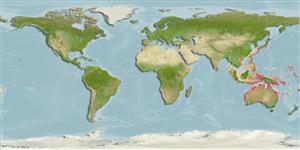>
Blenniiformes (Blennies) >
Tripterygiidae (Triplefin blennies) > Tripterygiinae
Etymology: Enneapterygius: Greek, ennea = nine times + Greek, pterygion = little fin (Ref. 45335).
Eponymy: Dr Helen K Larson was Curator of Fishes, Museum and Art Gallery of the Northern Territory, Darwin, Australia (1981–2009), retiring as Emeritus Curator, and is now a Research Associate at the Museum of Tropical Queensland, Townsville. [...] (Ref. 128868), visit book page.
More on author: Fricke.
Environment: milieu / climate zone / depth range / distribution range
Ecologia
marinhas demersal; não migratória; intervalo de profundidade 0 - 12 m (Ref. 13227). Tropical
Southwest Pacific: Papua New Guinea and Australia.
Tamanho / Peso / Idade
Maturity: Lm ? range ? - ? cm
Max length : 3.5 cm SL macho/indeterminado; (Ref. 13227)
Descrição suscinta
Chaves de identificação | Morfologia | Morfometria
Espinhos dorsais (total) : 14 - 17; Raios dorsais (total) : 8 - 12; Espinhos anais: 1; Raios anais : 14 - 20. Male dusky red with black "mask" covering most of head, chest, and pectoral-fin base, about 5 whitish saddles/bars on back (a few extending on lower side), and white bar on pectoral-fin base (immediately posterior to black area). Female mainly brownish or greenish with white bars. Dorsal rays III + XI-XIV + 8-12; anal rays I,14-20; pectoral rays 14-18; pelvic rays I,2; lateral line interrupted, 14-20 + 13-20; head, chest, and pectoral-fin base scaleless; lobate orbital tentacle; mandibular pores 3-4 + 1-2 +3-4. Maximum size to 4.4 cm TL (Ref. 90102).
Adults occur at shallow depths, often seen associated with coralline rocks, seagrass or algae (Ref. 13227). Eggs are hemispherical and covered with numerous sticky threads that anchor them in the algae on the nesting sites (Ref. 240). Larvae are planktonic which occur primarily in shallow, nearshore waters (Ref. 94114).
Ciclo de vida ou comportamento de acasalamento
Maturidade | Reprodução | Desova | Ovos | Fecundidade | Larvas
Fricke, R., 1994. Tripterygiid fishes of Australia, New Zealand and the southwest Pacific Ocean (Teleostei). Theses Zool. 24:1-585. (Ref. 13227)
Status na Lista Vermelha da UICN (Ref. 130435: Version 2024-2)
Ameaça para os humanos
Harmless
Uso pelos humanos
Pescarias: sem interesse
Ferramentas
Relatórios especiais
Baixar XML
Fontes da internet
Estimates based on models
Preferred temperature (Ref.
123201): 23.3 - 29.3, mean 27.9 °C (based on 1065 cells).
Índice de diversidade filogenética (Ref.
82804): PD
50 = 0.5000 [Uniqueness, from 0.5 = low to 2.0 = high].
Bayesian length-weight: a=0.00617 (0.00288 - 0.01322), b=3.04 (2.86 - 3.22), in cm total length, based on LWR estimates for this (Sub)family-body shape (Ref.
93245).
Nível Trófico (Ref.
69278): 3.1 ±0.3 se; based on size and trophs of closest relatives
Resiliência (Ref.
120179): Elevada, tempo mínimo de duplicação da população menor que 15 meses (Preliminary K or Fecundity.).
Fishing Vulnerability (Ref.
59153): Low vulnerability (10 of 100).
Nutrients (Ref.
124155): Calcium = 1370 [560, 6,275] mg/100g; Iron = 4.37 [1.63, 10.78] mg/100g; Protein = 17.4 [15.7, 19.0] %; Omega3 = 0.157 [0.038, 0.675] g/100g; Selenium = 93 [17, 373] μg/100g; VitaminA = 12 [2, 84] μg/100g; Zinc = 5.75 [2.55, 10.70] mg/100g (wet weight);
